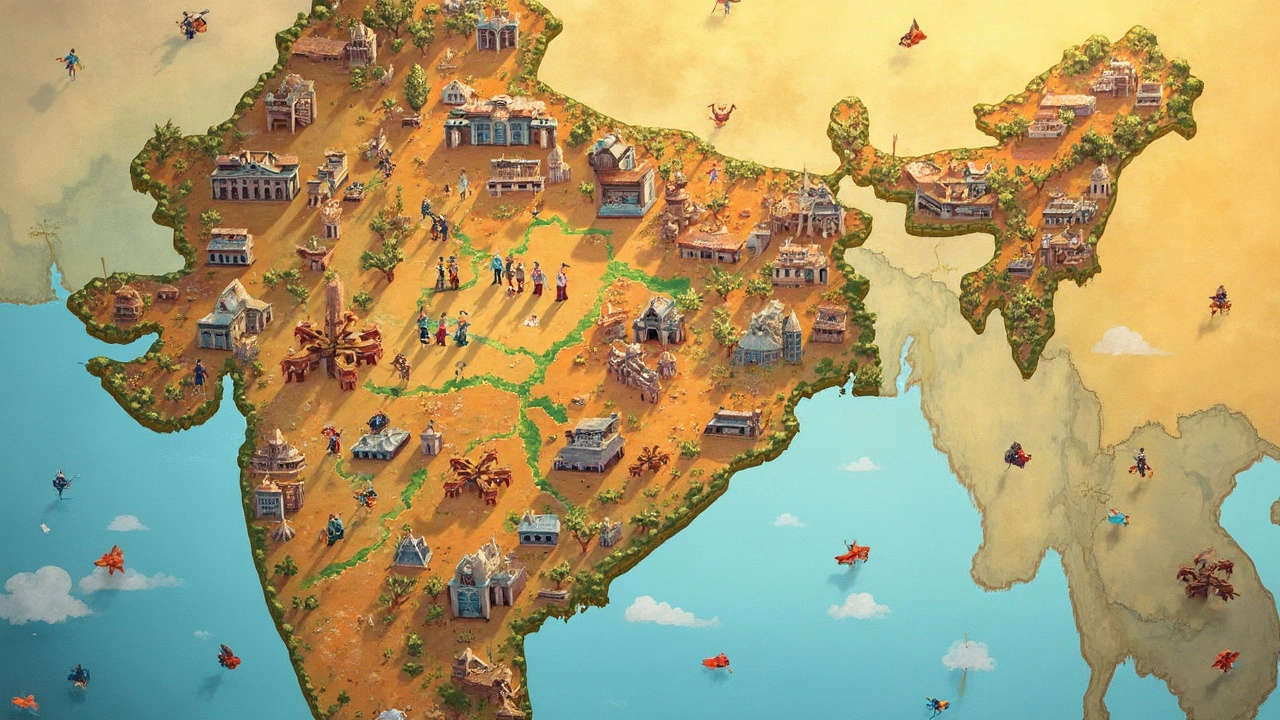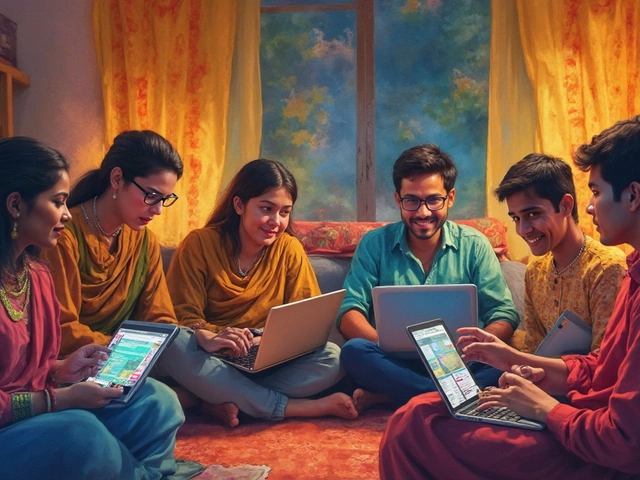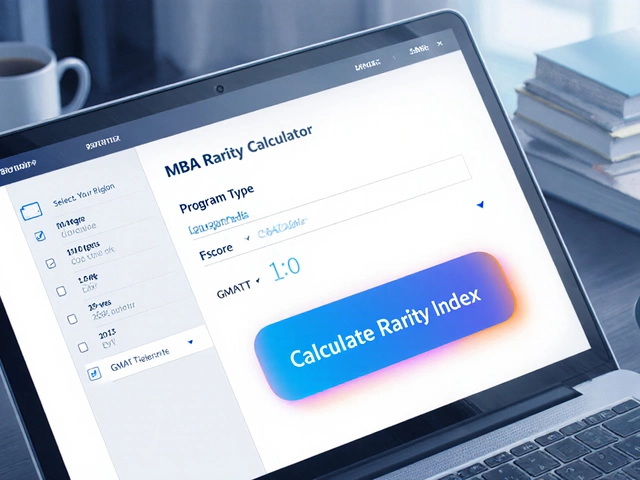
So, you're curious about CBSE schools, huh? Maybe you're wondering which Indian state has the most. Well, it's not just a numbers game—it's about understanding the educational scene. Spoiler alert: Uttar Pradesh leads the pack. Surprised? Or maybe you saw that coming. Either way, it's a big deal when you're considering education options.
Uttar Pradesh edges out the competition with a staggering count of CBSE-affiliated schools. Why? For starters, the sheer population size plays a part. But it's not just about numbers—there's more to it. With a widespread focus on competitive exams, CBSE's structured syllabus is what many look for in a school. Parents think it gives kids a leg up for college entrance exams.
- Introduction to CBSE
- The Leading State
- Reasons Behind the Numbers
- Impact on Students
- Tips for Selecting Schools
- Future Trends in Education
Introduction to CBSE
The Central Board of Secondary Education, better known as CBSE, is like the big name in Indian school education, especially if you're aiming for solid academic credentials. The government of India is behind CBSE, which gives it a certain credibility and rigorous standards many parents find appealing.
Why is CBSE such a big deal? For starters, its curriculum is consistent across the country. No matter where you study, you get access to the same coaching and material, which is a real advantage. Aside from this, CBSE's syllabus is designed in a way that aligns pretty well with major competitive exams in India, like JEE and NEET. If college entrance exams are on your radar, CBSE schools might just be the way to go.
CBSE's Role in Education
One interesting fact is that CBSE schools aren't just about academics. They're big on holistic education, meaning they emphasize both studies and extracurricular activities. The idea is that kids should not only excel in exams but also get various skills like teamwork and creativity.
And talk about innovation—CBSE has been pushing for new methods of learning! Whether it's through science fairs or computer workshops, there's always something happening. They even have special schemes like CCE (Continuous and Comprehensive Evaluation) which go beyond just textbooks and classroom lectures.
CBSE Schools in Numbers
With thousands of schools under its umbrella, CBSE is a huge network. And it just keeps growing! Just to put things into perspective, here's a snapshot:
| Year | Number of CBSE Schools |
|---|---|
| 2020 | 21,000+ |
| 2025 | 24,000+ |
So, the next time you hear about CBSE, you'll know it’s more than just a few schools in the neighborhood. It's a system aiming to prepare students for a successful future through a balanced and well-thought-out approach to education.
The Leading State
When it comes to the CBSE schools in India, Uttar Pradesh stands tall. Why is that? There are interesting factors at play beyond just its large population. With about 20% of India's population living here, it's no shocker that educational institutions are plentiful.
What Drives the Numbers?
Here's the scoop. Families in Uttar Pradesh are putting a major focus on education. There's a growing realization that the CBSE curriculum is advantageous for tackling competitive exams like the JEE and NEET—stepping stones to prestigious careers. So, the demand for CBSE schools in this region skyrockets.
Another thing to consider is the state's commitment towards improving education standards. Government initiatives and private investments are attracting schools to affiliate with CBSE. That makes it a win-win—students get better learning environments, while schools benefit from brand recognition.
Fast Facts
So, how many are we talking about? There are over 4,800 CBSE-affiliated schools in Uttar Pradesh. That's a sizeable chunk when you consider the nationwide total lies around 24,000. Some might say it's an educational hub.
| Year | Number of CBSE Schools |
|---|---|
| 2020 | 4,500 |
| 2023 | 4,800 |
This continuous growth in numbers reflects a consistent demand for quality education. And with the focus on grooming students for entrance exams, it's a trend that shows no signs of slowing.
Reasons Behind the Numbers
Okay, so here's the deal: You're probably wondering what's driving this CBSE school boom in Uttar Pradesh. Let's get into the nitty-gritty.
Population Matters
Uttar Pradesh is the most populous state in India. With over 200 million people, that's a lot of young minds needing an education. It’s no wonder CBSE schools are popping up everywhere. They're like the universal choice for parents aiming to give their kids a standard education that aligns with national benchmarks.
Focus on Competitive Exams
The CBSE curriculum is known for its balance of theoretical and practical knowledge, preparing students especially well for competitive exams like JEE and NEET. Parents believe this gives their kids a significant advantage, considering education is often viewed as a pathway to economic and social mobility. No surprise, CBSE is the preferred choice.
State Support and Recognition
The state government recognizes education as a cornerstone for development, so there's plenty of support for establishing CBSE schools. Plus, being centrally affiliated gives these schools a certain credibility, attracting more enrollments.
Rising Demand
With the increase in urbanization, there's also a rising demand for schools that provide a 'complete package' educational experience. CBSE schools, with their integrated approach, meet this demand feloniously.
Local Success Stories
A lot of this popularity also stems from local success stories. When kids from these schools crack competitive exams or bag top spots, it sets a trend, and other parents follow suit, hoping for similar success for their children.
The numbers tell quite the tale, right? Whether you're looking at it from a population angle, the prestige of competitive exams, or the state's backing, it's clear why CBSE schools have found such a fertile ground in Uttar Pradesh.

Impact on Students
Ever thought about how the sheer number of CBSE schools in a state like Uttar Pradesh can impact students? It's more than just a ranking stat. For students, this can totally change the learning experience.
First off, having more options means students can access different learning environments and extracurricular activities. Schools often compete to provide better facilities, quality teachers, and additional resources. So, students benefit from schools trying to be the best at what they offer.
In India, there's a big emphasis on doing well in entrance exams. With so many CBSE schools, students are more likely to be in touch with peers aiming for high scores. It's a kind of peer pressure that often pushes them to work harder.
Benefits of a Large CBSE School Network
- Access to Resources: More schools mean that educational resources are spread widely. Libraries, science labs, and computer facilities can be found even in remote areas.
- Preparation for Exams: Schools focused on the CBSE syllabus usually provide in-depth coaching and training for national-level exams like JEE and NEET.
- Network Expansion: Students build networks that could assist in higher education and career opportunities, owing to shared goals and school connections.
But there's a flip side. Sometimes, the pressure can be intense. Students in competitive environments often deal with stress and anxiety related to performance. It's crucial to strike a balance between taking advantage of available educational opportunities and maintaining mental well-being.
Overall, Uttar Pradesh's high number of CBSE schools creates an ecosystem rich in opportunities. It's a landscape where students can thrive if they navigate it wisely. Armed with the right information and strategies, they can make the most of their school years, paving the way for future success.
Tips for Selecting Schools
Choosing the right school for your child can be a game-changer. With CBSE schools all over India, it might feel like you're navigating a maze. But fear not! Let me break down some essential tips that'll make this task easier for you.
Research the Curriculum
The first step is understanding what the school offers in terms of curriculum. CBSE is famed for its balanced approach to education, but the school's implementation of it matters too. Ask about how they incorporate practical learning and if there are opportunities for co-curricular activities. The goal is to ensure they not only excel academically but also grow in other areas.
“A good school knows how to teach students how to learn, not just what to learn.” — Dr. Radhakrishnan, noted Indian educationist
Check the Location
Location might sound like a small detail, but it can impact your daily life significantly. A school closer to home can mean less travel stress and more time for your child to relax or pursue hobbies. If you’re eyeing a CBSE school in a different city, consider any relocation needs carefully.
Evaluate the Infrastructure
What's a school without the right facilities? Look for quality infrastructure. How well-equipped are the science labs? Is there a library and sports ground? A proper setup is crucial for a comprehensive educational experience.
Talk to Other Parents
Connecting with other parents can provide insights you won’t find in a brochure. They can share first-hand experiences about school culture, teacher interaction, and how engaged their child feels. Don’t underestimate the power of community feedback!
Understand Fee Structure
CBSE schools sometimes come with varied fee structures. Make sure you understand what you're paying for and if it includes extra-curricular activities. A transparent fee policy is key. You don't want surprises later on. Trust me.
Student-Teacher Ratio
A lower student-teacher ratio means more individual attention for each child. This can make a huge difference in how your kid learns. Most parents prefer a step-up in personalized learning these days.
Global Recognition and Results
Lastly, take a look at how the school's students perform in national exams and global contests. A strong track record shows the school’s commitment to delivering quality education.
Remember, your choice of school will play a vital role in your child’s future. Keep these tips in mind, do your due diligence, and you’ll be well on your way to choosing the perfect school!
Future Trends in Education
Education never stands still. With the rapid pace of change, it's no wonder everyone's talking about what's coming next, especially in CBSE schools. These days, one buzzword seems to be at the center of it all: technology. Tech is transforming the classroom experience, with digital learning tools and online resources playing major roles. In CBSE schools, the integration of digital resources isn't just a trend, it's here to stay.
Personalized Learning
Kicking things off, personalized learning is making big waves. Instead of a one-size-fits-all approach, tech enables teachers to tailor lessons to fit different student needs. So, if a kid's rockin' math but struggling in English, their educational journey can adapt. Awesome, right?
Blended Learning
Next up, blended learning is becoming more popular. It's all about mixing traditional classroom teaching with online educational tools. Imagine kids using engaging apps to solve problems. This approach isn’t about replacing teachers but combining methods for the best outcomes.
Data-Driven Insights
Another future trend? Data. Schools can now track progress with detailed analytics, helping teachers understand students' strengths and weaknesses. It's not just about grades anymore but also about detailed feedback to help students improve continuously.
Focus on Life Skills
Finally, the importance of soft skills is climbing the ladder. Schools are focusing more on teaching life skills like critical thinking, teamwork, and communication. The idea is to prepare kids for real-world challenges, not just exams.
The future looks bright and packed with potential. With CBSE schools leading some of these innovative changes, students are bound to be well-equipped for both higher education and the world beyond.




